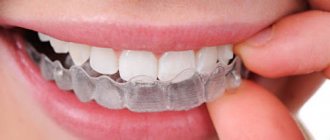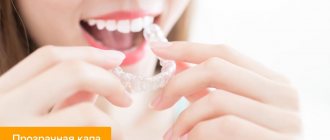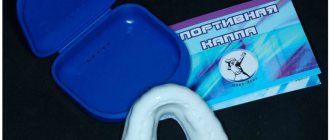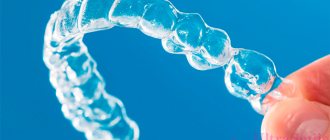Enamel is the hardest tissue in the body. Its density is determined by the minerals it contains. When their quantity decreases, the enamel loses its properties, quickly collapses, and the patient complains of sensitivity to hot and cold. Remineralizing therapy in dentistry allows you to restore hard tissues and prevent the development of caries.
| Prices for remineralizing therapy | |
| Remineralizing therapy (for 2 jaws) | 3200 R |
What is a dental guard?
In modern dentistry, there are many types of mouth guards, differing in their purpose.
With its help, it can protect teeth, promote their alignment, whiten and strengthen tooth enamel. A mouthguard is a removable device, i.e. a dental cover made of transparent material that covers the entire dentition. A dental mouth guard can be used to protect teeth during times of increased stress, such as during sports, to whiten teeth, straighten teeth, and reduce stress on the jaw.
The principle of operation of the cap is mechanical pressure on areas requiring correction. Each tooth is located in a specific socket and is surrounded by connective tissue that holds it in place. If constant pressure is applied to it, over time the tooth will change position.
Enamel composition, imbalances
The main chemical elements that form tooth enamel are calcium and phosphorus. Poor nutrition, changes in pH in the oral cavity, active proliferation of bacteria, and changes in the composition of saliva lead to a decrease in the concentration of microelements. This leads to tooth decay and the need for dental treatment.
Factors provoking demineralization:
- diseases of the digestive system;
- lack of microelements in the diet;
- accumulation of food debris, plaque formation;
- inflammation of soft tissues;
- poor dental care;
- smoking, excessive consumption of tea, coffee;
- destruction of enamel under the influence of mechanical factors;
- decreased immunity;
- hormonal disorders;
- simultaneous consumption of cold and hot foods and drinks;
- elderly age;
- lack of calcium and phosphorus during pregnancy, active skeletal growth in a child.
Types of mouth guards
Silicone mouth guards for athletes
Sports or protective mouthguards are designed for those who play contact sports such as hockey, football, boxing or prefer extreme recreation. These mouthguards on the front teeth help reduce the mechanical impact on the jaw and prevent damage not only to the teeth and soft tissues of the face, but also to the cervical spine.
There are two types of protective sports mouth guards:
- standard mouth guard - made according to a single sample and completely ready for use;
- custom mouth guards - made from biopolymers based on personal impressions, which allows you to reproduce all the structural characteristics of the dentition.
Orthodontic aligners
These are structures for aligning the dentition, made according to individual impressions of the patient’s jaws. Unfortunately, not all of these bite-correcting mouthguards are able to cope with serious malocclusions. They are mainly effective in eliminating interdental spaces and correcting some malocclusion pathologies. However, when it comes to Invisalign® orthodontic aligners, they can easily be considered as an alternative to braces.
Mouth guards for teething
There is another type of dental aligner: trainers. They are also called teething guards, teething guides or LM activators. Various models of this type of mouthguard are made of silicone. They are available in different sizes. Despite the name, teething protectors are actually used to correct the jaw relationship and align the incisors in children between the ages of 6 and 10 years, which is the early stage of malocclusion. How long to wear the aligners? The child needs to wear the mouthguards for several hours, day and night. The treatment period is usually about one year with periodic monitoring of intermediate results based on impressions of the jaws taken at various stages of correction.
Teeth whitening trays
If you want to achieve a genuine smile, but for some reason in-office whitening procedures are not an option for you, you can make your teeth whiter at home with professional systems using a custom, standard or disposable thermoplastic dental tray whitening gel. However, if this is the case, you will still need to visit your dentist to take an impression and make your own mouth guard or simply learn how to use a mouth guard. At the same time, be prepared for the fact that the whitening process using this technology will be slow and will take at least a month, since the percentage of hydrogen peroxide in the gel is lower than in office whitening systems. But this method is considered most suitable for teeth with increased sensitivity.
How to wear a teeth whitening tray at home? First you need to brush your teeth, apply the gel inside the tray and put it on, pressing lightly so that the gel is evenly distributed. Next, you need to rinse your mouth and put on the mouth guard for the time specified in the instructions. Then remove the mouthguard and rinse your mouth with water again.
Dental mouthguards
Dental mouth guards are also used for remineralization procedures. A special gel or paste is applied to the inner surface of the mouthguard and pressed tightly against the teeth. Regular use of a device filled with a mineralizing composition can effectively strengthen and restore tooth enamel. These mouthguards come in standard and thermoplastic varieties. A thermoplastic dental tray is made of a flexible material that softens when immersed in hot water. After this, it is immediately applied to the teeth and the material hardens.
Mouth guards for fluoridation
The principle of using this device is similar to that described above. As the name implies, such mouth guards are used to enhance the mineralization of tooth enamel (fluoridation); Therefore, fluoride-containing preparations are used.
Before using fluoridation trays, the patient should have their teeth professionally cleaned.
Fluoridation is also a medical procedure (but involves home implementation); Therefore, it should be carried out as prescribed and under the supervision of a physician.
Indications and contraindications for the use of mouth guards
Effective results are achieved with mouth guards only if they are used according to the wearing instructions. There are the following indications for which aligners should be used as part of orthodontic treatment:
- too large spaces between teeth (gaps);
- crowding, curling of teeth;
- enlarged or narrowed dental arch;
- as the final stage of using braces (instead of retainers).
- whitening effect.
Mouthguards correct slight crooked teeth, while they are completely invisible when worn, they can also be temporarily removed and then fixed again. If the patient is forced to hold an important event, a business meeting, such mobility of this product can greatly facilitate negotiations. The patient can remove this medical device for a couple of hours and then put it back on.
An interesting method of whitening with caps was developed by doctors who began to use this product together with special whitening pastes saturated with fluoride and potassium, which help reduce tooth sensitivity. In addition, the composition of the whitening paste itself may vary depending on the degree of yellowing of the teeth. This procedure is not a panacea for all patients. This method requires medical supervision. It has a number of contraindications. It means:
- allergic reactions to the components of the whitening paste;
- age less than 18 years;
- gum disease and some dental problems;
- wearing earrings in the lip area (piercing).
Mouth guards can only be used for minor defects in the dental system that lead to disruption of the aesthetics of the smile. An orthodontist will not prescribe the use of caps for severe bite deviations, since in this case the treatment will not be able to bring a positive result.
Mouth guards for bruxism
Bruxism is nighttime teeth grinding, in which, due to involuntary contraction of the masticatory muscles, an excessive load on the dental system occurs, which leads to various pathologies.
Consequences of bruxism:
- Abrasion of tooth enamel, increased sensitivity of teeth;
- Chips and cracks in enamel;
- Wedge-shaped defects;
- Fracture of the dental crown;
- Periodontitis;
- Inflammation of the gums;
- Damage to fillings, prosthetic structures;
- Pain in the maxillofacial joints;
- Headache;
- Loose teeth.
Bruxism is treated by therapists, psychologists, and neurologists; the disease is treated in a dental clinic by an orthopedist and an orthodontist; if necessary, a periodontist is involved. One way to combat nighttime teeth grinding is a protective mouth guard, which is worn only while sleeping.
Mouth guards for bruxism are made according to individual impressions; most often they are made for one jaw, but it is also possible to make a two-jaw unloading mouth guard. The mouthguard reduces the load on the maxillofacial joints, thanks to it the teeth do not close together, so there is no close contact between them. With regular use of the device, the number of bruxism attacks per night is reduced, teeth and orthopedic structures are preserved from damage. Mouthguards are made of lightweight elastic material, so they do not interfere with falling asleep and staying asleep.
In case of bruxomania - daytime teeth grinding - the patient is recommended to wear daytime mouthguards (if he is not able to independently control the force of jaw clenching). The devices have a special structure, so they are not visible during conversation and do not interfere with eating.
It should be borne in mind that a mouthguard for bruxism should be used in conjunction with therapeutic therapy; psychologists, neurologists, and possibly other specialists also participate in the treatment.
Do mouthguards help straighten teeth?
In search of a means to correct dentition, many people wonder whether straightening teeth with mouth guards will bring the expected effect. Their fears are related precisely to the wrong choice of caps, which does not lead to the expected result. Remember: only specially designed mouth guards made according to your impression right in the clinic are suitable for correcting your bite and straightening your teeth. Sports masks, whitening or remineralizing masks are not intended for this! In addition, there are a number of rules that must be followed when wearing a mouthguard, otherwise you will not benefit from all their benefits.
How to wear a dental mouthguard correctly
Depending on the structure of the jaw and the recommendations of the orthodontist, a dental guard can be worn:
- Constantly (20-22 hours a day, taking off just to eat and brush your teeth). This method is chosen if it is necessary to correct the bite, eliminate diastemas, or correct the position of the teeth relative to each other. It is completely safe, even aesthetically pleasing: many celebrities constantly wear transparent aligners - they are practically invisible.
- Only for the night. This applies to dental night guards, which are prescribed to maintain the effect achieved by the appliance when the bite has already been aligned and only need to be maintained.
The mouthguards are very easy to use: they are easy to put on and easy to remove without assistance. To care for them, just clean them with a regular toothbrush and rinse well with water. In addition, mouthguards should not be used to chew gum or eat other foods that stick to the teeth (taffy, butterscotch).
To check the evenness of your bite, you need to visit your dentist every 2-3 months. The doctor will determine how long to wear the mouth guard - typically, the duration of wearing the mouth guard is 3 years or more.
Features of wearing mouth guards to correct teeth bite
Aligners are made after a comprehensive examination of the oral cavity and determination of the nature of the defect. Based on the cast, a plaster model is created, which serves as a guide for making the trays. Several pairs may be needed during the entire course of treatment. This is because the aligners need to be replaced every 2-3 weeks to gradually move the teeth and correct the bite.
It is advisable to wear the structures for at least 20–22 hours a day. They are allowed to be removed while eating, so you don’t have to give up your usual foods.
Aligner care includes:
- brushing the outside with a soft brush and toothpaste twice a day;
- rinsing with clean water after each meal;
- storage after removal in protective containers with ventilation holes;
- protection from mechanical or chemical influences (cannot be immersed in hot water).
You can find out all the nuances of bite correction using mouthguards from the orthodontists of the Vimontale aesthetic dentistry clinic.
Expert of the article you are reading:
Bystrov Alexey Albertovich
Dentist orthodontist, general dentist
You may also be interested in:
Aligners Ceramic braces Lingual braces Combined braces Trainers for teeth straightening Treatment with braces Braces for children
Show more
Advantages and disadvantages of caps
Wearing this orthodontic design provides the patient with a number of advantages:
- made of transparent material and invisible to others;
- These are removable devices that allow for complete oral hygiene and food intake;
- in the manufacture of caps, hypoallergenic and safe materials for enamel and mucous membranes are used;
- do not cause speech impairment;
- period of rapid adaptation;
- copes well with bite problems in children and is actively used in pediatric orthodontics;
- easy to care for during daily hygiene procedures, does not require special detergents or special cleaning methods;
- works well in complex therapy in the treatment of teeth grinding and bruxism.
The disadvantages include:
- does not correct serious malocclusions;
- the time of using the mouth guard is controlled by the patient himself, so the result largely depends on his conscientiousness;
- The aligner does not correct serious defects - crowded teeth, severe curvature;
- the high cost of some types of hats.
Indications
Remineralization for preventive purposes is often carried out in childhood, starting from 6 years. This therapeutic procedure serves as a prevention of caries, which often affects fragile teeth. For adults, the procedure is recommended after removing hard deposits, removing orthodontic structures, and whitening. It is also carried out during pregnancy, lactation, and for dental anomalies.
For medicinal purposes, remineralization is indicated for caries in the stain stage, increased tooth sensitivity, with objective signs of decreased calcium and phosphorus levels, mechanical damage, impaired mineral metabolism in the body, congenital hypoplasia, and fluorosis.
Care of mouth guards
The orthodontic product must be kept clean; the effectiveness and duration of treatment largely depends on this. Patients themselves remove and apply the patch and check hygiene.
How to properly care for your aligners:
- the structure is cleaned daily with toothpaste and a toothbrush, rinsed with running water;
- inserts are regularly inspected for damage and wear; it is not recommended to wear a defective mouthguard;
- in case of breakdown, the patient is provided with other replacement models or the patch is remade;
- after each removal of the cap, rinse under running water to remove bacterial plaque from the surface;
- During the period of teeth straightening, it is not recommended to smoke or use chewing gum;
- The removable model is stored in an individual container with special perforations for ventilation.
Mouthguards for correcting bites can be an independent treatment measure or part of complex therapy. The use of such pads does not cause discomfort and does not require changes to your usual lifestyle and feeding. The treatment has no side effects, its adequacy is determined by a qualified orthodontist.
Who can benefit from teeth whitening with gel trays? Important nuances
Most often, this method is used by people whose teeth have turned yellow due to negative external influences:
- Smoking (nicotine changes the color of teeth).
- Drinking large doses of coffee or tea (same thing).
- Taking drugs of the tetracycline group (the enamel turns yellow or even acquires an orange tint).
- Age-related changes (in older people).
To achieve good results, it is necessary to take into account that the whitening effect will not last long (or will be weak) if negative factors are not excluded during the use of the tray and at the end of the course. Of course, age-related changes do not apply to this, but smoking or consuming too much coffee or tea is undesirable.
Note! Fillings and dental implants DO NOT WHITEN. Therefore, if the filled areas are in a “prominent place”, or the front real teeth alternate with artificial ones, it is better not to use mouthguards (there will be a contrast in shades).
Preparing for treatment with mouth guards
Before starting treatment with an orthodontist, it is necessary to eliminate inflammation in the oral cavity, cure caries and remove decayed teeth. A mandatory step is professional hygiene, removal of tartar and plaque, and teaching the patient the rules of oral hygiene. Main stages of preparation for treatment:
- conducting diagnostic studies, studying the results of radiography, CT, photographing the initial situation in the oral cavity;
- creation of three-dimensional models of jaws;
- manufacturing of mouth guards according to a specific program of tooth movement;
- Explaining to the patient all the details of the process, coordinating all issues.
The aligner works slowly, so be patient to achieve the cosmetic results you desire.
Medical Internet conferences
Relevance.
According to foreign and domestic authors, the prevalence of caries today reaches about 99% [1-5]. Caries is a pathological process that develops after a tooth has erupted and is accompanied by a decrease in the content of mineral components of the hard tissues of the tooth and the formation of a defect in the form of a cavity. Caries in the white spot phase is the initial stage of the carious process. Only this stage is the only reversible one. The main task of caries treatment at this stage is to protect the enamel from increasing demineralization and restore the best mineral composition [6-10]. The classic method of treating initial caries is remineralizing therapy. The pharmacological exchange offers many drugs for remineralization therapy, including calcium-containing drugs in the form of gels. However, their price categories are different.
Purpose: comparison of two modern drugs for remineralization therapy.
Objectives: 1. Study the composition of drugs for remineralization therapy, indications for use.
2. Conduct a comparative assessment of drugs for retherapy.
Materials and methods. In the process of work, the content of dental journals was mastered, an analysis of Russian and foreign articles, as well as various websites and brochures was carried out.
Results and discussion. The most common disease currently is caries [11-14]. The carious process is accompanied by demineralization of hard tooth tissues. Demineralization is the loss of minerals from tooth tissue. The enamel contains crystals of hydroxyapatite, carbonate apatite, fluorapatite, etc. The predominant mineral components of apatites are calcium and phosphates. The surface layer of enamel differs from the deep layers in its greatest mineralization, resistance to caries, and a higher content of “trace elements” [15-18]. Mineralization, i.e. the development of hard tooth tissues and filling them with mineral components occurs during intrauterine development, when the tooth is in the rudimentary position and lasts after eruption. At the same time, the chewing surfaces of the tooth are predominantly mineralized, and the cervical areas, fissures, and pits of the teeth are the least mineralized. It has also been established that the permeability of enamel is not identical for different substances [19-21]. The penetrating ability of organic substances (organic acids) is greater and that of calcium and fluorine to a lesser extent. Due to the fact that the cervical area, fissures and blind pits of the teeth are the least mineralized, the permeability of the enamel in these areas is greater. At the initial stages of caries development, the pathological process is first concentrated in the subsurface layers of the enamel, which provokes changes in its physicochemical properties, resulting in the formation of a white carious spot. Calcium and phosphorus are lost from the defective area, the density of the enamel decreases, and its solubility increases. With the formation of focal demineralization, decalcification is mainly realized, and the Ca/P indicator decreases [22-24]. This process is reversible. Under suitable conditions and under the influence of remineralizing drugs, calcium ions return to the crystal lattice.
For comparative characteristics, preparations were selected: based on Casein Phosphopeptide - Amorphous Calcium Phosphate (gel No. 1) and based on calcium glycerophosphate (gel No. 2). Gel No. 2 appears to be the basis of readily available combinations of calcium, phosphorus and magnesium, which recreate the crystal lattice of enamel. The structure of this drug includes calcium glycerophosphate, magnesium chloride, xylitol and a complex of polysaccharides. Xylitol included in the gel increases the remineralizing biopotential of the complex, and also weakens the activity of bacteria that provoke the formation of caries. When the gel is applied to the tooth, a film appears, due to which the active elements are consistently infiltrated into the tooth tissue. The gel does not contain fluoride, making it harmless when swallowed, suitable for children from infancy, and effective in combating caries in areas with increased fluoride content in drinking water. Remineralizing therapy using gel is practiced for various clinical cases: prevention of caries; treatment of caries in the initial stage; treatment of non-carious lesions such as hypoplasia and fluorosis; with dental hypersensitivity; during a whitening course; during orthodontic treatment; may be offered to persons undergoing chemotherapy. The only contraindication may be intolerance to certain components of the drug in particular cases. Gel No. 1 also contains bioavailable calcium and phosphorus. The composition of the drug contains the active component - Recaldent, which contains the CPP-ACP complex (casein phosphopeptide - amorphous calcium phosphate). The CPP-ACP compound is produced from milk casein. Milk casein is the owner of active substances; it seamlessly combines with enamel, biofilm and dental plaque, supplying calcium and phosphorus where they are most needed. Amorphous calcium phosphate complex is a balanced combination that is similar to the lost components of tooth enamel and supplies free calcium and phosphate ions to the tooth enamel. Along with this, saliva increases the activity of the CPP-ACP complex, and the sweet taste of the remineralizing agent increases salivation. The longer the complex and saliva interact in the oral cavity, the better the result. The indications for this gel include: prevention and treatment of initial caries; elimination of enamel hypersensitivity; treatment of teeth with non-carious lesions; retherapy after teeth whitening; during orthodontic treatment; use after professional oral hygiene; to normalize salivation. Contraindicated for persons allergic to milk proteins, because Recaident CPP-ACP complex is formed from cow's milk casein. The method of using these drugs is almost the same. Remineralizing agents are applied with a cotton swab or mouthguard to the surface of the tooth after professional oral hygiene in the dental office or at home after brushing your teeth. After using gel No. 2, you must refrain from eating and drinking for 30-40 minutes. After applying gel No. 1, you need to leave the drug on the tooth surface for 3 minutes. After using your tongue, you need to spread the cream over the surface of your teeth and try not to spit or swallow saliva for as long as possible. The longer the gel and saliva interact, the better the result. After this, you need to carefully spit out the saliva and, if possible, do not rinse your mouth with water. It is further recommended not to eat or drink for 30 minutes. It is recommended to use both gels periodically, in courses of 2-4 weeks. A number of clinical studies were reviewed. To compare these drugs, the following criteria were chosen:
1. Increased acid resistance of enamel after a full course of remineralizing therapy. 2. Rate of remineralization.
3. The effect of remineralization on tooth color.
Based on the outcome of the study, it was found that the rate of increase in acid resistance of enamel was higher in the Gel No. 1 group. The highest rate of remineralization is approximately 1.3 days in the Gel No. 1 group and 1.5 days in the Gel No. 2 group. An analysis of the effect of remineralizing therapy on the color of teeth showed that remineralization with Gel No. 2 leads to the highest lightening of teeth (Fig. 1).
Conclusions: 1. Both drugs are sources of accessible calcium, phosphorus and magnesium compounds, which renew the enamel crystal lattice. The leading components of drug No. 2 are calcium glycerophosphate, magnesium chloride, xylitol and a complex of polysaccharides. At the same time, xylitol increases the remineralizing ability of the complex. The composition of drug No. 1 includes Recaldent, which contains the CPP-ACP complex (casein phosphopeptide - amorphous calcium phosphate). The CPP-ACP complex is produced from casein in milk. This complex delivers vacant calcium and phosphorus ions to tooth enamel. At the same time, saliva increases the dynamics of the CPP-ACP complex. The indications for use of these drugs are almost the same; 2. The increase in acid resistance of enamel and the rate of remineralization are higher with drug No. 1, and remineralization with drug No. 2 leads to the greatest lightening of teeth.











